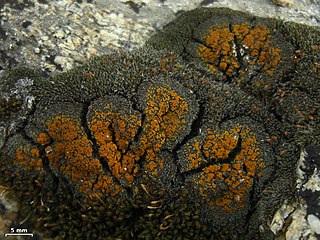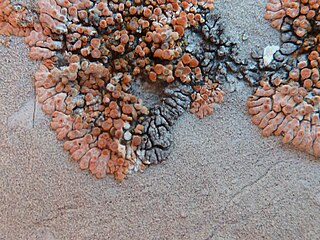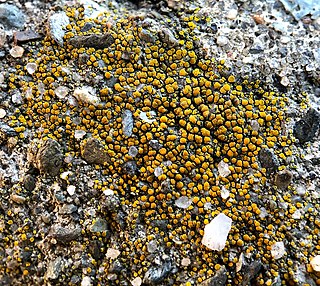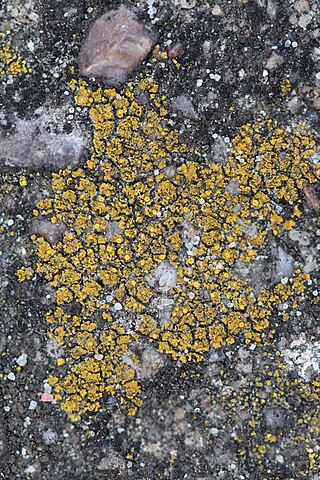
Flavoplaca is a genus of crust-like or scaly lichens in the family Teloschistaceae. It has 28 species with a mostly Northern Hemisphere distribution.

Xanthocarpia is a genus of mostly crustose lichens in the family Teloschistaceae. It has 12 species with a largely Northern Hemisphere distribution.

Parvoplaca is a genus of lichen-forming fungi in the family Teloschistaceae. The genus was circumscribed in 2013 by Ulrik Søchting, Patrik Frödén, and Ulf Arup.
Variospora cancarixiticola is a species of saxicolous (rock-dwelling), crustose lichen in the family Teloschistaceae. It is found in southeastern Spain, where it grows on cancarixite, a volcanic rock known only to occur in that country.

Calogaya arnoldii is a species of saxicolous (rock-dwelling), crustose lichen that is common and widespread in Europe and Asia. It is in the family Teloschistaceae. It was first formally described as a new species in 1876 by Hugh Algernon Weddell, as a species of Lecanora. After being transferred to Caloplaca in 1915, it was considered as a member of that genus for nearly a century. Molecular phylogenetic studies showed Caloplaca to be polyphyletic, and it was divided up into several smaller genera in 2013. Calogaya arnoldii was one of eight species transferred to the newly circumscribed Calogaya by Ulf Arup, Patrik Frödén, and Ulrik Søchting. The lichen is part of a species complex with complicated taxonomy, and in which intermediate phenotypes are frequently observed, making it difficult to reliably distinguish them. Calogaya saxicola is one such similar species, and it has often been confused with C, arnoldii in areas where they co-occur, as the differences between them are subtle.

Xanthocarpia feracissima is a species of saxicolous, crustose lichen in the family Teloschistaceae. It was first formally described as a new species in 1953 by Swedish lichenologist Adolf Hugo Magnusson, as a member of the genus Caloplaca. The type specimen was collected in 1939 by John Walter Thomson in Lake Koshkonong, Wisconsin. In the original description, Magnusson notes a similarity to the lichen now known as Gyalolechia flavovirescens, but distinguishes the new species by its lack of a visible thallus, the sordid-reddish color of its discs, and the "unusually narrow" septa of the spores. Patrik Frödén, Ulf Arup, and Ulrik Søchting transferred the taxon to Xanthocarpia in 2013, following molecular phylogenetic analysis of the family Teloschistaceae.
Solitaria is a fungal genus in the family Teloschistaceae. It contains a single species, the corticolous (bark-dwelling), crustose lichen Solitaria chrysophthalma.
Calogaya alaskensis is a species of crustose lichen in the family Teloschistaceae. It was first described as new to science in 2004 by Clifford Wetmore, who placed it in the genus Caloplaca. Ulf Arup and colleagues transferred the taxon to Calogaya in 2013 following a molecular phylogenetics-led restructuring of the Teloschistaceae.

Flavoplaca arcis is a species of saxicolous (rock-dwelling), crustose to squamulose (scaley) lichen in the family Teloschistaceae. Although widely distributed in Northern, Central, and Western Europe, it is not commmonly encountered.

Leproplaca cirrochroa is a widespread and common species of saxicolous (rock-dwelling), crustose lichen in the family Teloschistaceae. It grows up to 5 cm across, featuring a placodioid thallus with narrow, finger-like lobes that adhere closely to the surface, showing intricate division and ranging in colour from dirty orange to brownish orange, often with paler, pruinose orange ends.
Cerothallia subluteoalba is a species of corticolous (bark-dwelling), crustose lichen in the family Teloschistaceae. Found in Australia, it was described as a new species in 2009. This species is distinguished by its numerous bright yellow to soft yellow-orange apothecia, tiny spores with slim dividers (septa), and a barely distinguishable thallus that either fades away or grows inside its host.
Sirenophila maccarthyi is a species of corticolous/lignicolous, crustose lichen in the family Teloschistaceae. It has a thallus that is whitish or greyish, often inconspicuous and not always continuous, which can appear darker or dirty grey near its numerous, clustered apothecia. Sirenophila maccarthyi is distributed across regions including Western Australia, New South Wales, Victoria, Tasmania, and New Zealand, in both coastal and inland habitats. It typically grows on the bark and dead wood of a wide range of trees and shrubs such as Acacia sophorae, Araucaria excelsa, and various Eucalyptus species.
Xanthocarpia erichansenii is a species of terricolous (ground-dwelling), crustose lichen in the family Teloschistaceae. It is found in southwest Greenland, where it grows on loess among mosses.
Caloplaca sterilis is a corticolous (bark-dwelling), crustose lichen belonging to the family Teloschistaceae, described in 2011. It is primarily found in steppe and sand dune habitats in the Black Sea region, and has been recorded from Bulgaria, Romania, southwest Russia, and Ukraine. Caloplaca sterilis is characterised by tiny squamules/areoles with contrasting pale greyish-green to greenish soredia. It is easily overlooked and challenging to identify when completely sorediate and sterile, especially as its soredia do not contain the typical Sedifolia-grey pigment.
Fauriea trassii is a lichen species in the family Teloschistaceae, described in 2011. It is primarily found in the Far East of Russia, particularly in the Primorsky Krai region.

Flavoplaca limonia is a species of saxicolous (rock-dwelling), crustose lichen in the family Teloschistaceae. It was first formally described as a new species in 1994 by lichenologists Pier Luigi Nimis and Josef Poelt. Ulf Arup and colleagues transferred the taxon to the genus Flavoplaca in 2013, following a molecular phylogenetics-based restructuring of the family Teloschistaceae.

Flavoplaca maritima is a species of crustose lichen in the family Teloschistaceae. It is found in costal areas of Northern, Western, and Southern Europe. It mostly occurs on rocks, but has also been recorded growing on wood.

Polycauliona bolacina, the waxy firedot lichen, is a species of saxicolous (rock-dwelling), crustose lichen in the family Teloschistaceae. It is found in western North America.
Flavoplaca kantvilasii is a species of saxicolous (rock-dwelling), crustose lichen in the family Teloschistaceae. Found in Australia, it was formally described as a new species in 2007.
Flavoplaca arcisproxima is a species of saxicolous (rock-dwelling), crustose lichen in the family Teloschistaceae. It is found primarily in the coastal regions of the Crimean Peninsula and the eastern Mediterranean, particularly in Crete, Greece.










